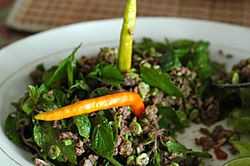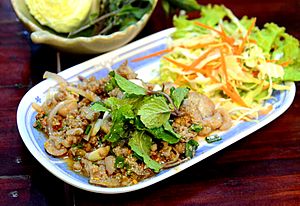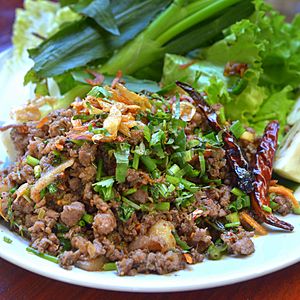Larb facts for kids

Larb made with cooked beef in Vientiane, Laos
|
|
| Alternative names | Lap, Larp, Lahp, Lahb, Laab |
|---|---|
| Type | Salad |
| Place of origin | Laos |
| Created by | Lao cuisine |
| Main ingredients | Meat (chicken, beef, duck, turkey, pork, or fish) |
| Variations | Several across the world |
Larb (Lao: ລາບ; Thai: ลาบ, RTGS: lap) is a super popular meat salad from Laos. It's even considered the national dish of Laos, along with green papaya salad and sticky rice.
People also enjoy Larb in other Southeast Asian countries. This is because Lao people have moved there and shared their cooking traditions. You can also find similar versions of Larb in places like Shan State, Burma, and Yunnan Province, China.
Contents
History of Larb: A Special Dish
Larb has been a favorite food for a long time. In 1883, a visitor named Étienne François Aymonier wrote about it. He said Larb was a mix of chopped onions, lemongrass, fermented fish, and chili. It was eaten with sticky rice.
Another visitor, Dr. Estrade, came in 1893. He described Larb as a main dish made with boiled fish, chili, and roasted sticky rice.
Different Ways to Make Larb
Larb can be made in many ways. It might be called nam tok, goi/saa, or yum/sua. It can use different meats like beef, chicken, duck, fish, or pork. Some versions even use mushrooms or algae!
You can eat Larb raw, which is called larb diip (raw larb) or aharn suer (tiger food). Or, it can be cooked. It's often served with a soup made from the bones of the meat used in the dish.
Larb for Special Occasions
Long ago, Larb was a special dish often enjoyed by important families. Old recipes show that royal chefs prepared Larb for Laotian kings and queens.
Larb is seen as a lucky dish. This is because meat wasn't always easy to get. So, people usually ate Larb on special days. These included weddings, New Year celebrations, and other festivals. Many Lao families believe eating Larb on the first day of the New Year brings good luck for the whole year.
In the past, preparing Larb was a big honor. Women in important families loved to show off their cooking skills by making Larb for guests. For everyday families, the ingredients were prepared separately. Then, the head of the family would mix everything together. This was a special tradition.
Types of Larb Dishes
Lao Style Larb
In Laos, the way Larb is made can change its name. It might be called nam tok, goi/saa, or yum/sua. Modern Larb often uses chicken, beef, duck, fish, pork, or mushrooms.
It gets its flavor from fish sauce, lime juice, a special sauce called padaek, and roasted ground rice. Fresh herbs are also added. The meat can be raw or cooked. It's usually minced (chopped very finely). Then it's mixed with chili, mint, and toasted ground rice. Sometimes, vegetables are added too. Larb is served at room temperature. It usually comes with sticky rice and fresh vegetables.
Traditionally, beef Larb might include certain parts of the animal and bile, but no lime juice. Fish and shrimp Larb also traditionally don't use lime juice. Instead, they use minced galangal. For fish and shrimp Larb, the fish or shrimp is pounded into a paste. Then, padaek juice is added carefully. Finally, finely chopped galangal and other herbs are mixed in.
Nam Tok: Waterfall Meat
Nam tok means 'waterfall' in Lao and Thai. This name comes from the meat juices dripping when it's grilled. Or, it could be from the juices that come out when medium-rare beef is sliced.
Nam tok is a popular meat dish in Laos and Thailand. It's like a type of Larb. It's made from barbecued pork or beef, often from the neck. The meat is sliced into bite-sized pieces. Then, it's boiled with some stock to make a sauce. After turning off the heat, sliced shallots, ground roasted rice, chili powder, lime juice, and fish sauce are added. Fresh coriander, spring onions, and mint leaves finish the dish.
Goi/Saa: Sliced Larb
Goi or Saa is a Larb-like dish where the meat is sliced thinly, not minced. In northern Laos, it's called saa. In southern Laos, it's known as goi.
Raw goi or saa made with the freshest fish is often served to very important guests. This is because it's a delicate dish that needs great knife skills. The raw fish is filleted, deboned, and sliced. Then, it soaks in saltwater and lime juice for a few minutes. This "cooks" the fish, similar to a dish called ceviche. After marinating, the fish is squeezed dry. The leftover marinade is mixed with padaek and boiled to make a sauce.
Finally, the fish is mixed with the sauce, roasted rice powder, chili flakes, and finely chopped herbs. These herbs include fennel, galangal, lemongrass, shallots, green onions, and mint. More salt or lime can be added for taste. The finished dish is a pale pink fish salad with green herbs. It's always served with fish bone soup, fresh vegetables, and sticky rice.
Yum/Sua: Boiled Chicken Larb
Another older style, popular with important families, is yum gai tom (boiled chicken) or sua gai (chicken). Recipes for royal yum gai tom can be found in old writings.
Yum gai tom is made by boiling a whole chicken with lemongrass, ginger, and kefir lime leaves. Once cooked, the chicken meat is removed and chopped or shredded. Chopped cucumbers and tomatoes (optional), chili peppers, roasted shallots, garlic, and toasted rice powder are added. Broth is added to moisten it, along with lime juice and fish sauce. Salt and pepper are added to taste. It's finished with spring onions and coriander.
Northern Thai (Lan Na) Style Larb
The larb from northern Thailand, called larb Lan Na, is different from the Lao style. Northern Thai Larb does not use fish sauce and is not sour. It doesn't use lime juice or other sour ingredients.
Instead, this version uses a mix of dried spices for flavor. These spices can include cumin, cloves, long pepper, star anise, prickly ash seeds, and cinnamon. These spices came from the Lan Na Kingdom's location on old spice trade routes to China. Ground dried chilies are also added. If the Larb is made with pork or chicken, animal blood might be included.
This dish can be eaten raw (larb dip). Or, it can be stir-fried for a short time (larb suk). If blood is left out of the stir-fried version, it's called larb khua (Thai: ลาบคั่ว). There's also a type of larb called larb luat (Lao: ລາບເລືອດ) or lu (Thai: หลู้). This dish is made with minced raw pork or beef, raw blood, and other parts. It's mixed with spices, crispy fried onions, and fresh herbs.
Larb and its different types are served with fresh vegetables and herbs. They are usually eaten with glutinous rice. This style of Larb is thought to have started in the town of Phrae, in northern Thailand. You can also find this type of Larb in parts of northern Laos.
See also
 In Spanish: Larb para niños
In Spanish: Larb para niños




